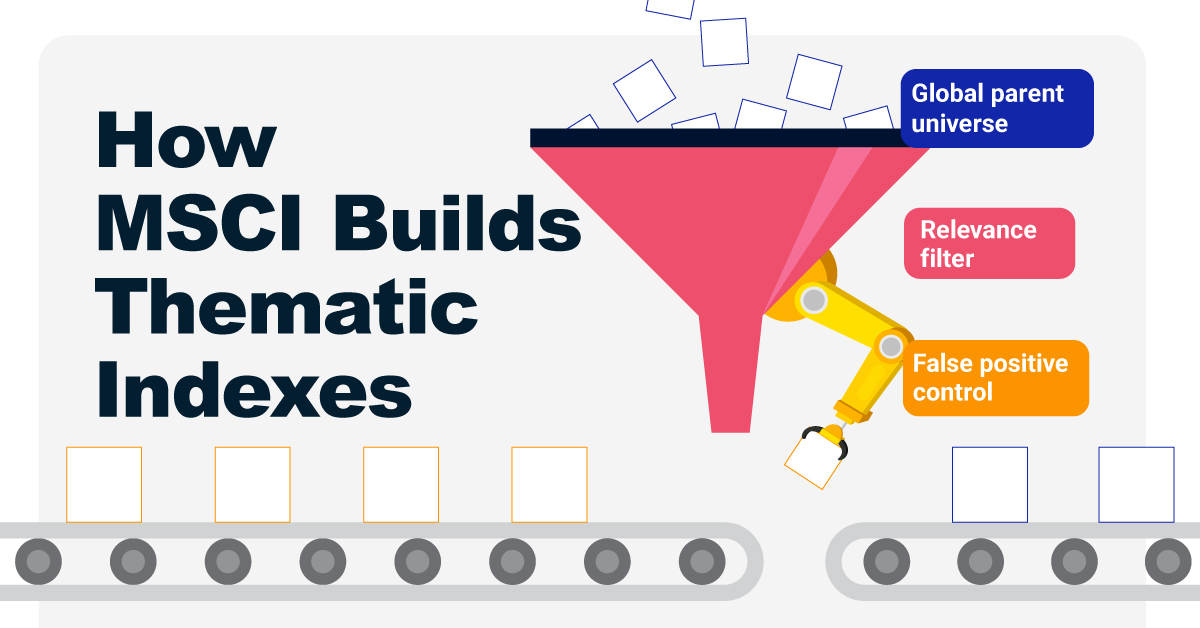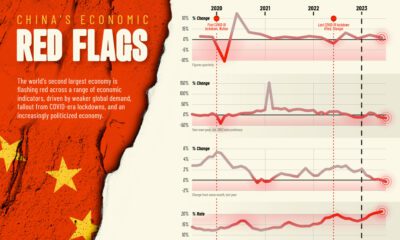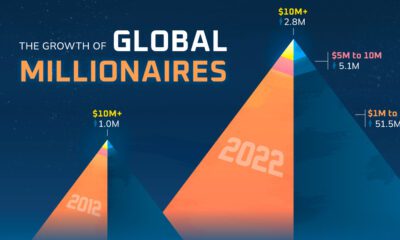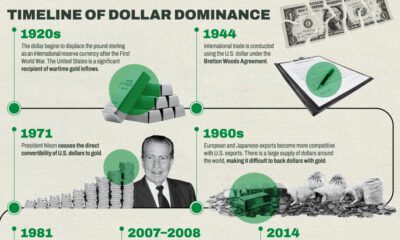Investor Education
How Currency Fluctuations Impact Canadian Investors

How Currency Fluctuations Impact Canadian Investors
For many Canadians, currency movements are an everyday part of life.
When the Canadian dollar is strong, it means that going south of the border is cheaper. Whether it’s a vacation in Hawaii or a shopping spree in New York City, a strong Canadian dollar can buy more in terms of U.S. dollars.
Likewise, a weak Canadian dollar can buy fewer U.S. dollars – meaning that travel, shopping, and other expenses in U.S. dollars are more expensive.
The Same Effect
The impact of currency fluctuations isn’t limited only to foreign purchases.
In fact, as today’s infographic from Fidelity Investments Canada shows, these same fluctuations can also affect the performance of your portfolio.
Why is that the case?
Many Canadian portfolios have exposure to American-listed companies such as Apple, Wells Fargo, Tesla, or Johnson & Johnson. As a result, fluctuations in the USD/CAD rate can have a profound impact on how these investments perform in Canadian dollars.
How Does This Work?
Here’s an example of the impact of currency in action:
- A Canadian investor puts $100 CAD into a fund that buys U.S. stocks
- At the time of investment, $1 CAD buys $0.80 USD
- After exchange, $80 USD is invested in the U.S. market
- The U.S. market goes up 10% in one year, and is now worth $88 USD
- However, over the year, the exchange rate changed to $1 CAD per $0.85 USD
- Converted back to Canadian dollars, at the new rate, the $88 USD is now worth $103.52 CAD, which is just a 3.5% gain in domestic Canadian currency
In the above case, a strengthening Canadian dollar ends up dampening the returns coming from the U.S. market.
In contrast, if the exchange rate went the other direction – meaning Canadian dollar was weakening – any returns would actually amplify.
Long-Term Planning
If currency fluctuations can have a substantial impact on investments, what does this mean for portfolio construction and assessing risk?
There are two main schools of thought on this:
Hedged: Some funds use a hedging strategy to try and cancel out any currency fluctuations. Ideally, the end result of this would be representative performance of the U.S. market.
Unhedged: This strategy does not try to anticipate currency fluctuations, since the long-term effects of currency movements tend to even out over time.
According to Fidelity Investments Canada, over the 20-year period of November 28, 1997 to November 30, 2017, the impact of currency fluctuations on the S&P 500 had a difference in annualized returns of 0.5%.
In other words, U.S. dollars invested in the S&P 500 had a 7.2% return, while Canadian dollars invested in the same stocks had a 6.7% return after adjusting for exchange rates.
Investor Education
How MSCI Builds Thematic Indexes: A Step-by-Step Guide
From developing an index objective to choosing relevant stocks, this graphic breaks down how MSCI builds thematic indexes using examples.

How MSCI Builds Thematic Indexes: A Step-by-Step Guide
Have you ever wondered how MSCI builds its thematic indexes?
To capture long-term, structural trends that could drive business performance in the future, the company follows a systematic approach. This graphic from MSCI breaks down each step in the process used to create its thematic indexes.
Step 1: Develop an Index Objective
MSCI first builds a broad statement of what the theme aims to capture based on extensive research and insights from industry experts.
Steps 2 and 3: List Sub-Themes, Generate Keyword List
Together with experts, MSCI creates a list of sub-themes or “seedwords” to identify aligned business activities.
The team then assembles a collection of suitable documents describing the theme. Natural language processing efficiently analyzes word frequency and relevance to generate a more detailed set of keywords contextually similar to the seedwords.
Step 4: Find Relevant Companies
By analyzing financial reports, MSCI picks companies relevant to the theme using two methods:
- Direct approach: Revenue from a company’s business segment is considered 100% relevant if the segment name matches a theme keyword. Standard Industrial Classification (SIC) codes from these directly-matched segments make up the eligible SIC code list used in the indirect approach.
- Indirect approach: If a segment name doesn’t match theme keywords, MSCI will:
- Analyze the density of theme keywords mentioned in the company’s description. A minimum of two unique keywords is required.
- The keyword density determines a “discount factor” to reflect lower certainty in theme alignment.
- Revenue from business segments with an eligible SIC code, regardless of how they are named, is scaled down by the discount factor.
The total percentage of revenue applicable to the theme from both approaches determines a company’s relevance score.
Step 5: Select the Stocks
Finally, MSCI narrows down the stocks that will be included:
- Global parent universe: The ACWI Investable Market Index (IMI) is the starting point for standard thematic indexes.
- Relevance filter: The universe is filtered for companies with a relevance score of at least 25%.
- False positive control: Eligible companies that are mapped to un-related GICS sub-industries are removed.
Companies with higher relevance scores and market caps have a higher weighting in the index, with the maximum weighting for any one issuer capped at 5%. The final selected stocks span various sectors.
MSCI Thematic Indexes: Regularly Updated and Rules-Based
Once an index is built, it is reviewed semi-annually and updated based on:
- Changes to the parent index
- Changes at individual companies
- Theme developments based on expert input
Theme keywords are reviewed yearly in May. Overall, MSCI’s thematic index construction process is objective, scalable, and flexible. The process can be customized based on the theme(s) you want to capture.

Learn more about MSCI’s thematic indexes.

-

 Investor Education5 months ago
Investor Education5 months agoThe 20 Most Common Investing Mistakes, in One Chart
Here are the most common investing mistakes to avoid, from emotionally-driven investing to paying too much in fees.
-

 Stocks10 months ago
Stocks10 months agoVisualizing BlackRock’s Top Equity Holdings
BlackRock is the world’s largest asset manager, with over $9 trillion in holdings. Here are the company’s top equity holdings.
-

 Investor Education10 months ago
Investor Education10 months ago10-Year Annualized Forecasts for Major Asset Classes
This infographic visualizes 10-year annualized forecasts for both equities and fixed income using data from Vanguard.
-

 Investor Education1 year ago
Investor Education1 year agoVisualizing 90 Years of Stock and Bond Portfolio Performance
How have investment returns for different portfolio allocations of stocks and bonds compared over the last 90 years?
-

 Debt2 years ago
Debt2 years agoCountries with the Highest Default Risk in 2022
In this infographic, we examine new data that ranks the top 25 countries by their default risk.
-

 Markets2 years ago
Markets2 years agoThe Best Months for Stock Market Gains
This infographic analyzes over 30 years of stock market performance to identify the best and worst months for gains.
-

 Mining2 weeks ago
Mining2 weeks agoCharted: The Value Gap Between the Gold Price and Gold Miners
-

 Real Estate1 week ago
Real Estate1 week agoRanked: The Most Valuable Housing Markets in America
-

 Business1 week ago
Business1 week agoCharted: Big Four Market Share by S&P 500 Audits
-

 AI1 week ago
AI1 week agoThe Stock Performance of U.S. Chipmakers So Far in 2024
-

 Misc1 week ago
Misc1 week agoAlmost Every EV Stock is Down After Q1 2024
-

 Money2 weeks ago
Money2 weeks agoWhere Does One U.S. Tax Dollar Go?
-

 Green2 weeks ago
Green2 weeks agoRanked: Top Countries by Total Forest Loss Since 2001
-

 Real Estate2 weeks ago
Real Estate2 weeks agoVisualizing America’s Shortage of Affordable Homes
















